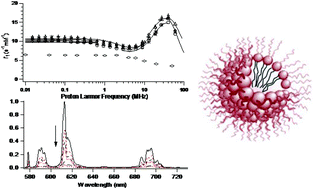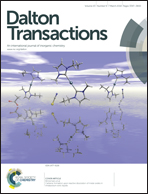Micellar self-assemblies of gadolinium(iii)/europium(iii) amphiphilic complexes as model contrast agents for bimodal imaging†
Abstract
The synthesis and characterization of two novel DTPA bisamide derivatives DTPA-BC12PheA and DTPA-BC14PheA functionalized with p-dodecylaniline and p-tetradecylaniline are described. The ligands were coordinated to Gd(III) and Eu(III), resulting in highly paramagnetic and luminescent complexes, respectively. Mixed micelles consisting of Gd/Eu-DTPA-BC12PheA and DTPA-BC14PheA with a homogeneous size distribution (33–40 nm) were prepared by the assembly of the amphiphilic complexes with phospholipid DPPC and a surfactant Tween 80®. Taking into account the sensitivity difference between magnetic resonance and optical imaging techniques, the ratios of Gd and Eu complexes (Gd/Eu) 1 : 1, 2 : 1, 3 : 1, 20 : 1 and 50 : 1 were combined in one single micelle and their optical and relaxometric properties were characterized in detail. Upon excitation at 290 nm, the micelles display characteristic red emission bands due to the 5D0→7FJ (J = 0–4) transitions of Eu(III). The number of water molecules in the first coordination sphere of Eu(III) (qEu = 0.1–0.2) was calculated from the lifetime measurements performed in H2O and D2O solutions. Micelles composed of exclusively europium complexes display quantum yields in the range of 1.0%, decreasing with the europium concentration when going from 1 : 1 to 50 : 1 Gd/Eu contents. The ligand-to-lanthanide sensitization efficiency for micelles consisting of Eu-DTPA-BC12PheA and Eu-DTPA-BC14PheA equals 3.8% and 4.1%, respectively. The relaxivity r1 per Gd(III) ion at 40 MHz and 310 K reaches a maximum value of 14.2 s−1 mM−1 for the Gd-DTPA-BC12PheA assemblies and 16.0 s−1 mM−1 for the micellar Gd-DTPA-BC14PheA assemblies compared to a value of 3.5 s−1 mM−1 for Gd-DTPA (Magnevist®). Theoretical fitting of the 1H NMRD profiles results in τR values of 4.2 to 6.6 ns. The optimal concentration ratio of Gd/Eu compounds in the micelles in order to provide the required bimodal performance has been determined to be 20 : 1. In the search for other bimodal systems, this discovery can be used as a guideline concerning the load of paramagnetic agents with respect to luminescent probes.


 Please wait while we load your content...
Please wait while we load your content...